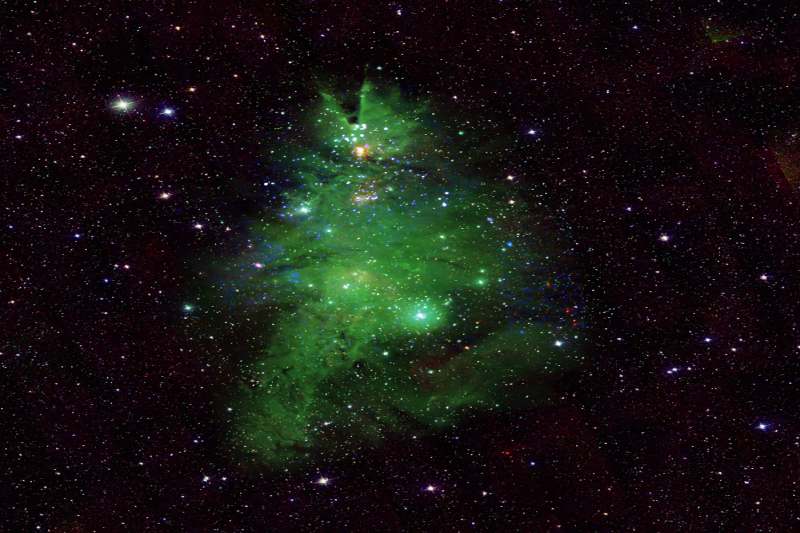
Ahead of the holidays, NASA releases “Christmas Tree” star images
- Science
- December 25, 2023
Not even a thousand light-years from Earth is a cluster of stars celebrating Christmas. This week, NASA released images that depict a cluster of stars from the NGC 2264 cluster shining brightly in the Milky Way’s blue, green, and white light spectrum.
Known as the “Christmas Tree Cluster,” this formation is known for having a base that is slightly shaped like a triangle and stems that extend out on all sides. This structure is similar to the widely used Norway spruce, which has become a holiday staple and tradition.
The cluster is depicted in a spitting pine green in renderings created by NASA researchers using data from two telescopes: the National Science Foundation’s Wisconsin-Indiana-Yale-NOAO (WIYN) Observatory and the agency’s own Chandra X-Ray Observatory. They also added sparkling white and bright blue dots to the stars in the cluster using infrared data from the Two Micron All Sky Survey, an astronomical study of the sky in infrared light. To make the image more recognizable as a Christmas tree, it has also been rotated 160 degrees from its original northern position.
NASA research indicates that the nebula, a cloud of gas and dust in space, is located in the faint constellation Monoceros on the celestial equator, some 2,500 light-years away. Several stars in the NGC 2264 formation are both larger and smaller than the sun; in fact, some of them have a mass of less than a tenth that of the sun.
German-British astronomer William Herschel made the discovery of the formation, which spans roughly seven light-years, in the 1780s. According to NASA, the surrounding area is also a hotbed for recently formed stars, which over millions of years have been eroding the nebula.
Numerous nebulae exist that bear resemblance to terrestrial objects or animals, including jellyfish, owls, and even the trunk of an elephant. Because of its butterfly-like gas clouds, the NGC 6302 formation in the constellation Scorpius is also known as the Butterfly Nebula.
Nebulas and their magnetic fields, which are produced by particles in a star’s interior, are frequently studied by scientists to better understand how stars behave, particularly when they die and transform into nebulas.
Similar image renderings, such as a horrifying purple and white hand from the nebula of a supergiant star that collapsed into a neutron star 16,000 light-years from Earth, have also been made possible by magnetic fields produced by NASA’s Chandra X-Ray telescopes, a NASA news release states.